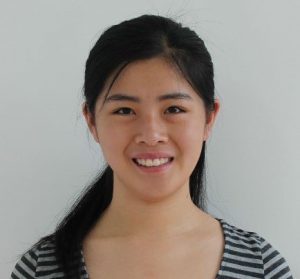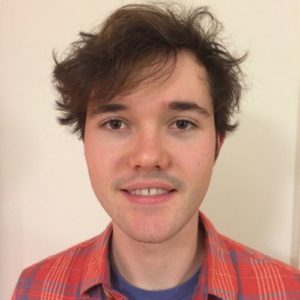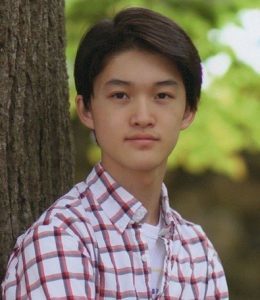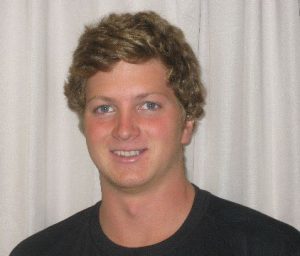Eight undergraduates have been awarded research funds from the Peter B. Lewis Fund for Student Innovation in Energy and the Environment and the Dede T. Bartlett P03 Fund for Student Research in Energy and the Environment. This competitive funding supports undergraduate research on energy- and environment-related projects, particularly field work and laboratory research. The recipients will spend eight weeks this summer working under the guidance of a faculty advisor. The students’ projects, described below, are aimed at providing solutions to energy- and environment-related challenges.
Six students were awarded funding for research in the summer of 2015.
 Sherry Bai ’19
Sherry Bai ’19
(Faculty Advisor – Barry Rand, Department of Electrical Engineering and the Andlinger Center for Energy and the Environment)
Title: Investigating the Impact of Doping on Organic Solar Cells
Abstract: The primary purpose of this internship is to study the effects of doping on organic semiconductors for solar cells. Doping inorganic semiconductors is a well-known process that forms the basis for inorganic solar cells, but research on the effects of doping on organic semiconductors for solar cells has been limited. We aim to systematically study the effects of doping on not only the electrical and optical properties of devices made with organic semiconducting materials, but also the optical properties of thin films fabricated with those materials.
 Eric Chen ’19
Eric Chen ’19
(Faculty Advisor – Barry Rand, Department of Electrical Engineering and the Andlinger Center for Energy and the Environment)
Title: Hall Effect Measurements for Energy-Relevant Semiconductors
Abstract: Measurements of the Hall effect are important for determining semiconductor properties such as doping type, carrier concentration, and carrier mobility. However, measuring the Hall effect in low-conductivity materials is difficult because the large capacitance and high resistance of these materials create voltage noise and drift that mask the Hall voltage signal. These low-conductivity thin films have broad applications in solar cells, LEDs, and other large area electronic devices. As a result, verifying the fundamental characteristics by accurately measuring the Hall effect is a critical first step for developing these energy devices. This project aims to improve Hall voltage measurements in low-conductivity materials by developing an automated measuring system. This system will connect power sources and sensors together to implement a slow changing magnetic field over long measurement times in order isolate the desired Hall voltage from other signals.
 Isabella Grabski ’18
Isabella Grabski ’18
(Faculty Advisor – Emily Carter, Department of Mechanical and Aerospace Engineering and the Andlinger Center for Energy and the Environment)
Title: Plasmon-Assisted Dissociation of Carbon Dioxide on Metallic Nanoparticles with Embedded Correlated Wavefunction Methods
Abstract: As climate change becomes a growing concern, it is increasingly important to reduce the amount of carbon dioxide, the most ubiquitous greenhouse gas, released into the atmosphere. One way to accomplish this is to capture and recycle carbon dioxide. The reverse water gas shift reaction is an industrially relevant way to utilize carbon dioxide by converting it to carbon monoxide through catalytic hydrogenation. A key step in this process is the adsorption of carbon dioxide on a metal catalyst and its subsequent dissociation, which will be studied computationally in this research project. My work in the summer will be to computationally study the dissociation of carbon dioxide on a metal catalyst using embedded correlated wavefunction methods.
 Theo Keeley-LeClaire ’18
Theo Keeley-LeClaire ’18
(Faculty Advisor – Jose Avalos, Department of Chemical and Biological Engineering and the Andlinger Center for Energy and the Environment)
Title: Post-Transcriptional Control Using Optically Activated Proteins
Abstract: The primary purpose of this internship is to investigate the effectiveness of optically activated proteins in post-transcriptional regulation of metabolic pathways in S. Cerevisiae, specifically the pathways involved in producing advanced long chain biofuels such as isobutanol. Long chain alcohols are attractive as biofuels because they have significantly higher energy densities than ethanol. Furthermore, they are more similar to gasoline and other traditional fuels than ethanol, which means long chain alcohols can be used as gasoline additives in higher concentrations and may eventually serve as direct substitutes. Developing methods to regulate the metabolic pathways that produce these long chain alcohols is critical to determining the viability of biofuels as a sustainable energy source.
 Andy Liu ’19
Andy Liu ’19
(Faculty Advisor – Jose Avalos, Department of Chemical and Biological Engineering and the Andlinger Center for Energy and the Environment)
Title: Mitochondria Engineering in Yeast for the Production of Isobutanol
Abstract: The overall goal of my work is to genetically enhance the ability of budding yeast to convert biomass into a source of renewable energy, namely biofuels. The investigation takes on a multi-disciplinary approach, combining the fields of systems biology, organelle engineering and cellular engineering, in order to achieve the most efficient conversion of biomass into advanced fuels such as isobutanol. My role in the research will involve modifying yeast mitochondria to increase the yield of isobutanol.
 Andrew Ma ’19
Andrew Ma ’19
(Faculty Advisor – Barry Rand, Department of Electrical Engineering and the Andlinger Center for Energy and the Environment)
Title: Enhancement of OLED Outcoupling Efficiency Using a Nanostructured Top Metal Electrode
Abstract: Lighting is currently a major source of worldwide energy consumption, and so moving to energy-efficient lighting is very important for global sustainability. Organic light emitting devices (OLEDs) represent an important potential player in the solid state lighting (SSL) area, and have a near 100% internal energy conversion efficiency. However, they are held back by relatively low light outcoupling efficiencies of 20-30%. The objective of this research project is to improve OLED light outcoupling efficiency, by reducing losses due to photon-plasmon coupling at the surface of the top metal electrode. Specifically, this will involve creating/testing a randomly nanostructured interface at the top metal electrode.
 Jason Mulderrig ’18
Jason Mulderrig ’18
(Faculty Advisor – Lex Smits, Department of Mechanical and Aerospace Engineering)
Title: Analysis of Helmholtz Resonance-Piezoelectric Energy Harvester via Wind Tunnel Tests
Abstract: My internship will be focused on performing wind tunnel tests of the various cavity designs of the Helmholtz resonance-piezoelectric energy harvester in order to determine areas of the energy harvester design that could be revised in order to improve efficiency. Different physical arrays of the energy harvester will also be explored. The physical properties of the energy harvester will be monitored by a pressure transducer, a laser displacement sensor, and stereoscopic particle image velocimetry. Finally, field tests of the energy harvester will be conducted on a rooftop on Princeton’s campus.
 Sam Smiddy ’17
Sam Smiddy ’17
(Faculty Advisor – Howard Stone, Department of Mechanical and Aerospace Engineering)
Title: Foam-Driven Fractures of an Elastic Matrix
Abstract: We report an experimental study of foam-driven fractures in an elastic matrix. When a pressurized foam is constantly injected into a gelatin matrix with a constant flow rate, the foam generates a disc-like fracture which is commonly observed in liquid-driven fractures. Compare to liquid-driven fractures, foam-driven fractures grow faster with time. We investigate how the rheological behavior of foams affects the fracture characteristics by varying the air volume fraction of the foam, the types and concentration of surfactants in the foam. Foamfracturing reduces the environmental costs of hydraulic fracturing, which inspires this laboratory study.